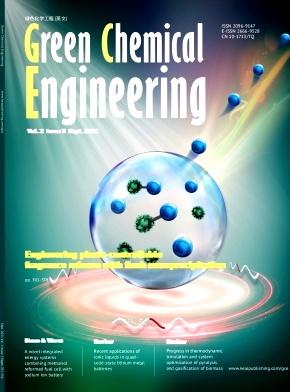Constructing potassium and hydroxyl co-doped dual-dipole structures on highly active 3D g-C3N4 surfaces for highly boosting photocatalytic hydrogen peroxide production efficiency in pure water
IF 7.6
Q1 ENGINEERING, CHEMICAL
引用次数: 0
Abstract
Producing hydrogen peroxide (H2O2) through visible-light-driven photocatalytic oxygen reduction in pure water is crucial for sustainable ecological applications but poses significant challenges. It include the rapid recombination of electron-hole pairs and a scarcity of effective catalytic sites, which traditionally limit the process efficiency. To address these issues, we have developed a novel catalyst, designated as KCNOH, which consists of a three-dimensional (3D) porous g-C3N4 framework doped with potassium (K+) and modified with surface hydroxyl groups (–OH). This design significantly enhances H2O2 yield, achieving 91.36 μmol g−1 h−1 (cut 420 nm)—a yield approximately 36 times higher than conventional bulk g-C3N4 (2.57 μmol g−1 h−1). The introduction of a 3D porous structure provides an abundance of active-sites. The dual-dipole mechanism, facilitated by K+ ions and hydroxyl groups, plays a pivotal role by efficiently transporting photogenerated electrons and consuming holes, respectively. Through density functional theory (DFT) calculations, the changes in the band structure of the catalyst caused by the doping of K+ and the grafting of –OH were elucidated. In addition, the transition state affinity of oxygen induced by the –OH was also studied to reveal the synergistic catalytic mechanism. This mechanism markedly reduces carrier recombination and accelerates charge migration, underscoring its importance in catalyst design. Our findings not only improve the understanding of charge dynamics but also open novel perspectives for the design of highly-efficient composite materials, which is crucial for energy and environmental applications.

在高活性三维g-C3N4表面构建钾和羟基共掺杂双偶极子结构,以提高纯水光催化过氧化氢生产效率
在纯水中通过可见光驱动的光催化氧还原生产过氧化氢(H2O2)对于可持续生态应用至关重要,但也面临着重大挑战。它包括电子-空穴对的快速重组和有效催化位点的缺乏,这限制了传统的工艺效率。为了解决这些问题,我们开发了一种新的催化剂,命名为KCNOH,它由一个三维(3D)多孔g-C3N4框架组成,其中掺杂了钾(K+),并用表面羟基(-OH)修饰。该设计显著提高了H2O2的产率,达到91.36 μmol g−1 h−1(切割420 nm),比常规g- c3n4 (2.57 μmol g−1 h−1)的产率提高了约36倍。三维多孔结构的引入提供了丰富的活性位点。由K+离子和羟基促进的双偶极子机制分别有效地传递光生电子和消耗空穴,起着关键作用。通过密度泛函理论(DFT)计算,阐明了K+掺杂和-OH接枝对催化剂能带结构的影响。此外,还研究了-OH诱导氧的过渡态亲和力,揭示了协同催化机理。这一机制显著减少了载流子重组,加速了电荷迁移,强调了其在催化剂设计中的重要性。我们的发现不仅提高了对电荷动力学的理解,而且为高效复合材料的设计开辟了新的视角,这对能源和环境应用至关重要。
本文章由计算机程序翻译,如有差异,请以英文原文为准。
求助全文
约1分钟内获得全文
求助全文
来源期刊

Green Chemical Engineering
Process Chemistry and Technology, Catalysis, Filtration and Separation
CiteScore
11.60
自引率
0.00%
发文量
58
审稿时长
51 days
 求助内容:
求助内容: 应助结果提醒方式:
应助结果提醒方式:


